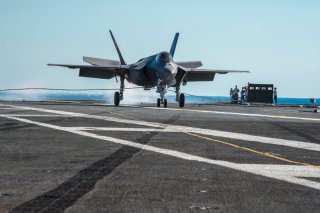Could the U.S. Achieve Air Dominance Over Taiwan?
Fourth and fifth-generation aircraft launched from maritime platforms could quickly try to intercept and destroy Chinese invasion forces.
If China were to launch an immediate, all-out attack on Taiwan, what kind of response might the United States and its allies be able to launch? Could such a Chinese attack be stopped, given that Taiwan is only 100 miles off the coast of mainland China?
A number of key variables would most likely impact this equation, such as the extent to which the U.S. and allied forces were sufficiently forward positioned in the Pacific region to respond quickly. Perhaps this is a key reason why the U.S. Navy conducts many forward training operations such as dual-carrier exercises and collaborative drills with Pacific allies. Fourth and fifth-generation aircraft launched from maritime platforms could quickly try to intercept and destroy Chinese invasion forces.
Along with maritime preparedness, there is another more impactful variable pertaining to fifth-generation aircraft. Should U.S. Navy amphibious assault ships or carriers carrying F-35Bs or with F-35Cs be within a few hundred miles of Taiwan, it does seem possible that a Chinese amphibious assault could be stopped. China only has a small number of fifth-generation J-20 aircraft and they are not capable of taking off and landing on ships. While they could reach the skies over Taiwan from mainland China, it seems extremely unlikely that a small number of J-20s could successfully provide air support for a Chinese amphibious assault. Should a comparable number of F-35s be within response range, it seems unrealistic that attacking Chinese amphibious forces would be able to achieve anything close to air supremacy. Given this circumstance, Chinese ships attacking Taiwan could be extremely vulnerable from the air. U.S. Navy amphibious assault ships, for example, can carry as many as thirteen F-35Bs able to perform vertical take-off and landing missions in support of maritime operations. During one of its first deployments, the USS America big deck amphibious assault ship traveled throughout the southern hemisphere carrying thirteen F-35s. Also, islands in southern Japan, such as Okinawa, are roughly 500-miles from Taiwan and could help U.S. and allied forces respond. An overwhelming amount of land and sea-launched 5th-generation aircraft could be well-positioned to counter a fast-advancing Chinese attack. This is particularly true because any Chinese naval formations preparing for such an offensive would be seen by satellites, giving U.S. and allied forces an opportunity to move into position.
This circumstance seems to be a significant potential factor affecting the question of whether China could quickly overtake Taiwan and generate a fait accompli where a massive U.S. and allied land invasion would be necessary to destroy Chinese forces. A Pentagon report on China earlier this year raised that possibility, expressing concern that China may be positioned to quickly annex Taiwan. However, by looking at the Pacific region’s geography, available forces in the region, and the potential to forward deploy U.S. assets, it seems quite realistic that land and air-launched F-35s could offer the best chance of destroying a Chinese amphibious assault on Taiwan.
Kris Osborn is the Defense Editor for the National Interest. Osborn previously served at the Pentagon as a Highly Qualified Expert with the Office of the Assistant Secretary of the Army—Acquisition, Logistics & Technology. Osborn has also worked as an anchor and on-air military specialist at national TV networks. He has appeared as a guest military expert on Fox News, MSNBC, The Military Channel, and The History Channel. He also has a Master's Degree in Comparative Literature from Columbia University.
Image: Flickr/U.S. Navy.

